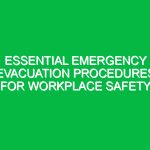Introduction
Hello, team! Today, we are conducting an essential Toolbox Talk focused on the topic of Working From Home within the Health, Safety, and Environment (HSE) domain. As many of us have adapted to remote work, it’s critical to ensure that our home working environments are safe and conducive to productivity. This talk aims to equip you with guidelines and Best Practices that promote well-being while working remotely. Let’s dive in!
Understanding the Importance of Working From Home HSE Guidelines
With the rise of remote work, the need for Working From Home HSE guidelines has never been more significant. These guidelines help prevent workplace accidents and promote a healthy work-life balance. By adhering to these principles, we can ensure that our home office setups contribute positively to our productivity and overall health.
Potential Hazards and Risks
When we think about Safety in the workplace, our minds often go to physical Hazards like machinery or slips and falls. However, Working From Home presents its own unique set of risks. Here are some potential hazards to consider:
- Ergonomics: Poorly designed workspaces can lead to musculoskeletal disorders. An improper chair or desk height can cause back pain and repetitive strain injuries.
- Distractions: Home environments are rife with distractions, from household chores to family members. These distractions can lead to accidents and decreased productivity.
- Isolation: Working alone can lead to feelings of isolation and anxiety, impacting mental health.
- Fire hazards: Using electronic equipment improperly or overloading circuits can pose fire risks.
Best Practices for a Safe Home Workspace
Now that we’ve discussed potential risks, let’s explore some Best Practices for creating a safe and effective workspace while Working From Home.
1. Ergonomic Setup
Creating an ergonomic workspace is essential to prevent injuries. Here’s how to do it:
- Chair: Invest in a chair that supports your lower back. Your feet should rest flat on the floor, and your knees should be at a right angle.
- Desk Height: Your desk should allow your elbows to be at a 90-degree angle when typing.
- Monitor Position: The top of your monitor should be at eye level to prevent neck strain. Ensure you are sitting at least an arm’s length away.
2. Create a Dedicated Workspace
Having a designated area to work helps separate your professional life from your personal life. This will help you maintain focus and establish a routine. Choose a quiet area, free from distractions, where you can concentrate on your tasks.
3. Manage Distractions
Distractions can significantly affect your productivity and Safety. Here are some strategies:
- Set Boundaries: Communicate with family members about your working hours. Use visual cues, like a closed door or a “do not disturb” sign.
- Stay Organized: Use to-do lists or productivity apps to keep track of your tasks.
- Take Breaks: Schedule regular breaks to avoid burnout and maintain focus.
4. Stay Connected
Feeling isolated can impact your mental health. Make it a point to connect with your colleagues regularly:
- Use Video Calls: Schedule regular check-ins via video conferencing tools to foster collaboration.
- Participate in Team Activities: Engage in virtual team-building activities to maintain camaraderie.
Health and Wellness Considerations
While focusing on physical safety is crucial, we must not overlook mental health. Here are some wellness tips to consider while Working From Home:
- Maintain a Routine: Stick to a regular schedule to create a sense of normalcy.
- Exercise: Incorporate physical activity into your day, even if it’s a short walk or stretching.
- Mindfulness: Practice techniques such as meditation or deep breathing to manage stress.
Regulations and Compliance
It’s essential to be aware of any Regulations or company policies related to Working From Home. Compliance with these Standards is crucial for the safety of all employees. Familiarize yourself with:
- Company Policies: Ensure you understand your company’s remote work policies, including equipment usage and Data Security.
- Health and Safety Regulations: Be aware of any local regulations that pertain to home offices and work environments.
Adhering to these regulations not only protects you but also ensures the company is compliant with legal obligations.
Actionable Advice for Working From Home
As we wrap up our Toolbox Talk, here are some actionable pieces of advice to implement immediately:
- Evaluate Your Workspace: Take time to assess your home office setup. Make necessary adjustments to improve ergonomics.
- Establish a Routine: Develop a daily schedule that includes work hours, breaks, and personal time.
- Communicate: Keep an open line of communication with your team. Share any challenges you face while Working From Home.
Discussion and Engagement
Before we conclude, I would like to open the floor for discussion. Here are a few questions to consider:
- What challenges have you faced while Working From Home?
- How do you manage distractions effectively?
- What tips do you have for maintaining a healthy work-life balance?
Engaging in discussions can help us learn from each other and improve our remote working experience.
Conclusion
To summarize, Working From Home presents various challenges and opportunities. By following the HSE guidelines we discussed today, we can create a safer, healthier, and more productive work environment. Remember to evaluate your workspace, establish a routine, and communicate openly with your colleagues.
Thank you all for your attention and your commitment to maintaining a safe working environment. Together, we can ensure that our remote work practices promote health, safety, and productivity.


